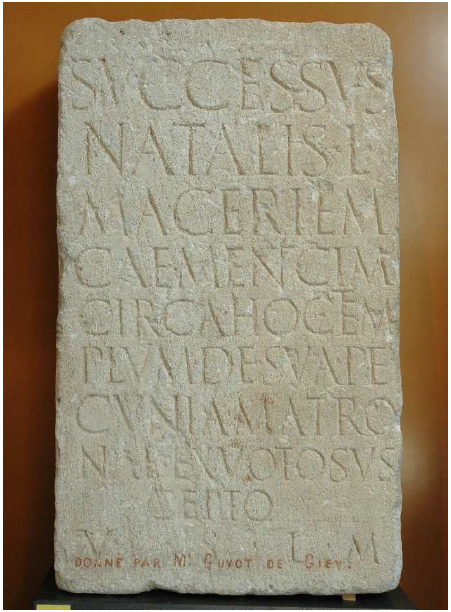a) Epigraphy and Sanctuary
An inscription engraved on an altar in grey limestone, probably dating from the 2nd c. AD, was discovered in Balesmes-sur-Marne (Haute-Marne) in July 1831 by a farmer. It is dedicated to the goddess Matrona, the personification of the River Marne. The inscription reads: Successus Natalis l(ibertus) maceriem caementiciam circa hoc templum de sua pecunia Matronae ex voto suscepto v(otum) s(olvit) l(ibens) m(erito), ‘Successus, freed from Natalis, had this outer wall in rubble stones built around this temple at his own expense in honour of Matrona, after making a vow, and paid his vow willingly and deservedly’ (fig. 24).1852 The dedicator Successus is a freed slave who bears a Latin name. His old master, Natalis, also has a Latin name and is a peregrine*, since he bears the unique name. This inscription is highly interesting, for it mentions a sanctuary erected in honour of the goddess Matrona. The dedicator offers the outer wall surrounding the temple in gratitude for the accomplishment of a vow.
Thirty years earlier, in May 1805, ruins of Gallo-Roman buildings had been found in a field located in a place known as ‘La Marnotte’, five kilometres south-east of Langres, near Balesmes-sur-Marne (Haute-Marne). Excavations carried out by Mr. Devaraigne at the spring of the river revealed no less than twelve rooms, some of which were equipped with hot baths, fragments of paintings in fresco, fragments of marble from the surrounding rocks, a pipe engraved with the initials of the founder of the baths TI. CL. ATT. F. and a dozen copper coins with the effigy of Titus (79 -81 AD) and Nero (54-68 AD).1853 This indicates that the sanctuary was certainly erected at the beginning of the 1st c. AD. The temple to Matrona, mentioned in the inscription, must have been part of those buildings.1854
Matrona’s name is undeniably Celtic. As studied in Chapter 1, Matrona is derived from the Gaulish mātīr, ‘mother’, cognate with Old Irish máthair, ‘mother’, gen. máthar, which all come from Indo-European *mātēr signifying ‘mother’.1855 Matrona (‘Divine Mother’) is the singular form of Matronae (‘Mother Goddesses’), honoured in multiple inscriptions from the Rhineland and Cisalpine Gaul (see Chapter 1).
